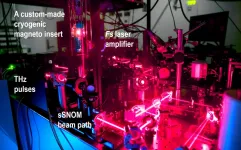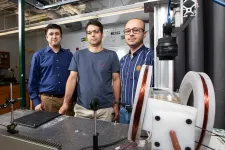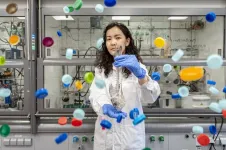(Press-News.org) A team of scientists from the Department of Energy’s Ames National Laboratory have developed a way to collect terahertz imaging data on materials under extreme magnetic and cryogenic conditions. They accomplished their work with a new scanning probe microscope. This microscope was recently developed at Ames Lab. The team used the ultralow temperature terahertz microscope to take measurements on superconductors and topological semimetals. These materials were were exposed to high magnetic fields and temperatures below liquid helium (below 4.2 Kelvins or -452 degrees Fahrenheit).
According to Jigang Wang, a scientist at Ames Lab, professor of Physics and Astronomy at Iowa State University, and the team leader, the team has been improving their terahertz microscope since it was first completed in 2019. “We have improved the resolution in terms of the space, time and energy,” said Wang. “We have also simultaneously improved operation to very low temperatures and high magnetic fields.”
To expand their terahertz microscope’s capabilities to operate at extreme cryogenic and magnetic environments, Wang explained that his team developed a custom microscopy insert for a cryostat. A cryostat is a device used to maintain extremely cold temperatures. This insert was designed specifically for use with the cryogenic terahertz microscope.
The new microscope capabilities allowed the team to examine superconductors and topological semimetals, both which operate at these low temperatures. These materials can also move electricity with almost zero energy loss and are important for furthering quantum computing technology.
Based on their research so far, Wang said that the microscope could lead to development of new, improved materials for highly coherent quantum devices and a better understanding of superconducting and topological materials.
This research is further discussed in the paper, “A sub-2 Kelvin Cryogenic Magneto-Terahertz Scattering-type Scanning Near-Field Optical Microscope (cm-THz-sSNOM),” written by R. H. J. Kim, J.-M. Park, S. J. Haeuser, L. Luo, and J. Wang, and published in Review of Scientific Instruments.
Ames National Laboratory is a U.S. Department of Energy Office of Science National Laboratory operated by Iowa State University. Ames Laboratory creates innovative materials, technologies, and energy solutions. We use our expertise, unique capabilities, and interdisciplinary collaborations to solve global problems.
Ames Laboratory is supported by the Office of Science of the U.S. Department of Energy. The Office of Science is the single largest supporter of basic research in the physical sciences in the United States and is working to address some of the most pressing challenges of our time. For more information, please visit https://energy.gov/science.
END
Ultralow temperature terahertz microscope capabilities enable better quantum technology
2023-05-12
ELSE PRESS RELEASES FROM THIS DATE:
New study puts a definitive age on Saturn’s rings—they’re really young
2023-05-12
A new study led by physicist Sascha Kempf at the University of Colorado Boulder has delivered the strongest evidence yet that Saturn’s rings are remarkably young—potentially answering a question that has boggled scientists for well over a century.
The research, to be published May 12 in the journal Science Advances, pegs the age of Saturn’s rings at no more than 400 million years old. That makes the rings much younger than Saturn itself, which is about 4.5 billion years old.
“In ...
Researchers identify a brain marker indicating future suicide risk
2023-05-12
FOR IMMEDIATE RELEASE, May 12, 2023
Contact: Gina DiGravio, 617-358-7838, ginad@bu.edu
Researchers Identify a Brain Marker Indicating Future Suicide Risk
Changing the connectivity in this brain circuit with stimulation or pharmacotherapies could represent new treatments to reduce suicide risk.
(Boston)—Identifying people at high risk for suicide is critical for applying lifesaving interventions and treatments. However, it is very difficult to identify who is at greatest risk and only modest improvements has been made in identifying high risk people over the last 50 years. One novel way to identify people at high risk of suicide is by investigating and identifying brain markers.
VA ...
Researchers use 3D models to investigate bacteria movement
2023-05-12
The spiral-shaped bacteria Helicobacter pylori are common and troublesome.
More than 13 percent of Americans have an H. pylori infection, although rates vary with age, race and socioeconomic status. The microorganism uses its corkscrew-like tail to power forward through viscous fluids such as stomach mucus. When it arrives at the epithelium of the stomach wall, it can cause everything from ulcers to cancer.
In a new study published by Physical Review Letters, FAMU-FSU College of Engineering researchers created a 3D model of this bacteria to better understand its movement, hoping to crack the code governing the organism’s motility ...
Researchers at Purdue discover superconductive images are actually 3D and disorder-driven fractals
2023-05-12
Meeting the world’s energy demands is reaching a critical point. Powering the technological age has caused issues globally. It is increasingly important to create superconductors that can operate at ambient pressure and temperature. This would go a long way toward solving the energy crisis.
Advancements with superconductivity hinge on advances in quantum materials. When electrons inside of quantum materials undergo a phase transition, the electrons can form intricate patterns, such as fractals. A fractal is a never-ending pattern. When zooming in on a fractal, the image looks the same. Commonly seen fractals can be a tree or frost on a windowpane ...
Save the phages to protect Big Blue
2023-05-12
The plastic era has begun, and for sure, it will last for decades or even longer. Polymer-based materials are almost everywhere, reaching even the deepest regions of the oceans, and their global production is larger than recycling, leading to the generation of tremendous amounts of water pollution with microplastics. These tiny polymer particles not only release chemicals but also reduce the number of bacteriophages. Recently, researchers from the Institute of Physical Chemistry, Polish Academy of Sciences, led by Prof. Jan Paczesny, explored ...
Head and neck cancer organoids as a step towards personalized treatments
2023-05-12
Researchers from the Organoid group (Hubrecht Institute) and UMC Utrecht have developed a biobank with organoids derived from patients with head and neck cancer (HNC). They used this biobank to validate known HNC biomarkers and found that treatment responses in the organoids matched those seen in patients. The results of the study will be published in Med on 12 May 2023 and could aid treatment decisions and discovery of novel therapies for HCN patients in the future.
Head and neck cancer (HNC) is an overarching term used for several types of cancer, including the most ...
Intestinal bacteria influence the growth of fungi
2023-05-12
The bacteria present in the intestine provide information about the quantities of fungi of the potentially disease-causing Candida genus. Among them, and surprisingly, are lactic acid bacteria that are known for their protective effect against fungal infections. The findings of researchers at the Leibniz Institute for Natural Product Research and Infection Biology (Leibniz-HKI) and their collaborative partners from Denmark and Hungary add another piece to the puzzle of understanding the human gut microbiome.
The ...
Researchers discover novel "Shanghai APP" mutation in late-onset Alzheimer's disease, offering new avenues for treatment
2023-05-12
Alzheimer's disease (AD) is a progressive neurodegenerative disorder affecting tens of millions of people worldwide, and it is the most common cause of dementia. Early-onset AD is typically associated with mutations in the genes APP, PSEN1, and PSEN2, leading to a more aggressive form of the disease with atypical symptoms. In contrast, the newly discovered "Shanghai APP" mutation has been linked to LOAD, which affects a larger population of AD patients.
In a study published in Genes & ...
Breakthrough technology: Carbon nanotube membranes with Pd-Cu modification successfully reduce nitrate levels via electrocatalysis
2023-05-12
The adverse effects of excess nitrate in water on human productivity and lives have received increasing attention due to the discharge of industrial wastewater and the overuse of farmland fertilizers. An international team of researchers has conducted an in-depth study of the significant need and challenge of efficient nitrate removal.
Several techniques have been used to eliminate nitrate from water, such as biological denitrification is technologically mature, cost-effective, and widely used. However, biological processes are often sluggish and ...
Samsung Electronics – DGIST, establishment of ”Semiconductor Contracting Department” for fostering semiconductor development talent
2023-05-12
□ DGIST (President Yang Kook) (the following three science and technology institutions) will establish a "Semiconductor Contracting Department" with Samsung Electronics for fostering technical staff specialized in semiconductor manufacturing processes.
□ DGIST closed a business agreement on the 27th (Mon) at DGIST University Center Convention Hall for establishing and operating the Semiconductor Contracting Department, which was attended by Samsung Electronics President Seokwoo Nam and Wanpyo Kim, DGIST President Yang Kook, and other major stakeholders.
□ Owing to the recently increasing global semiconductor demand, safeguarding national competitiveness ...





